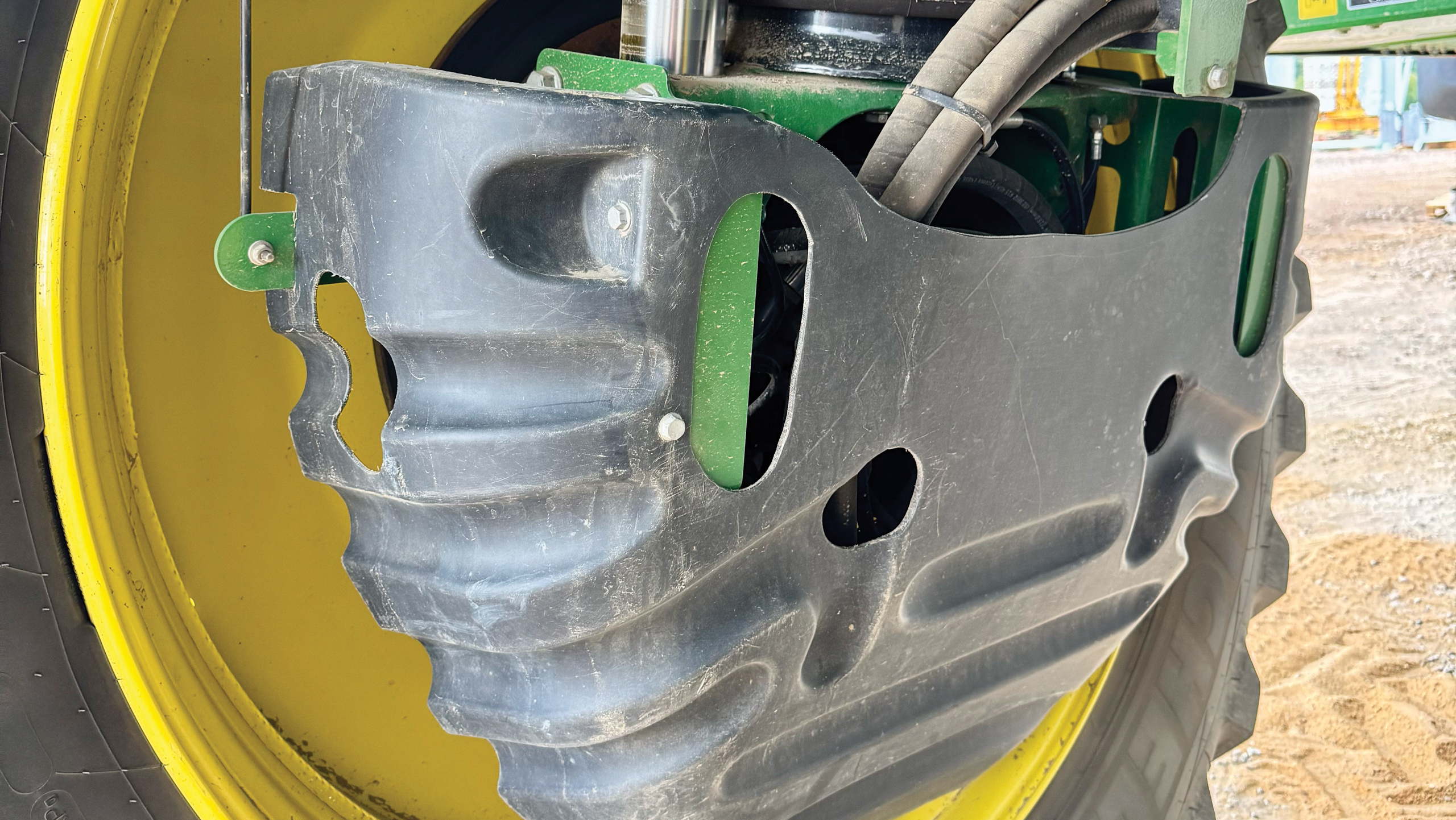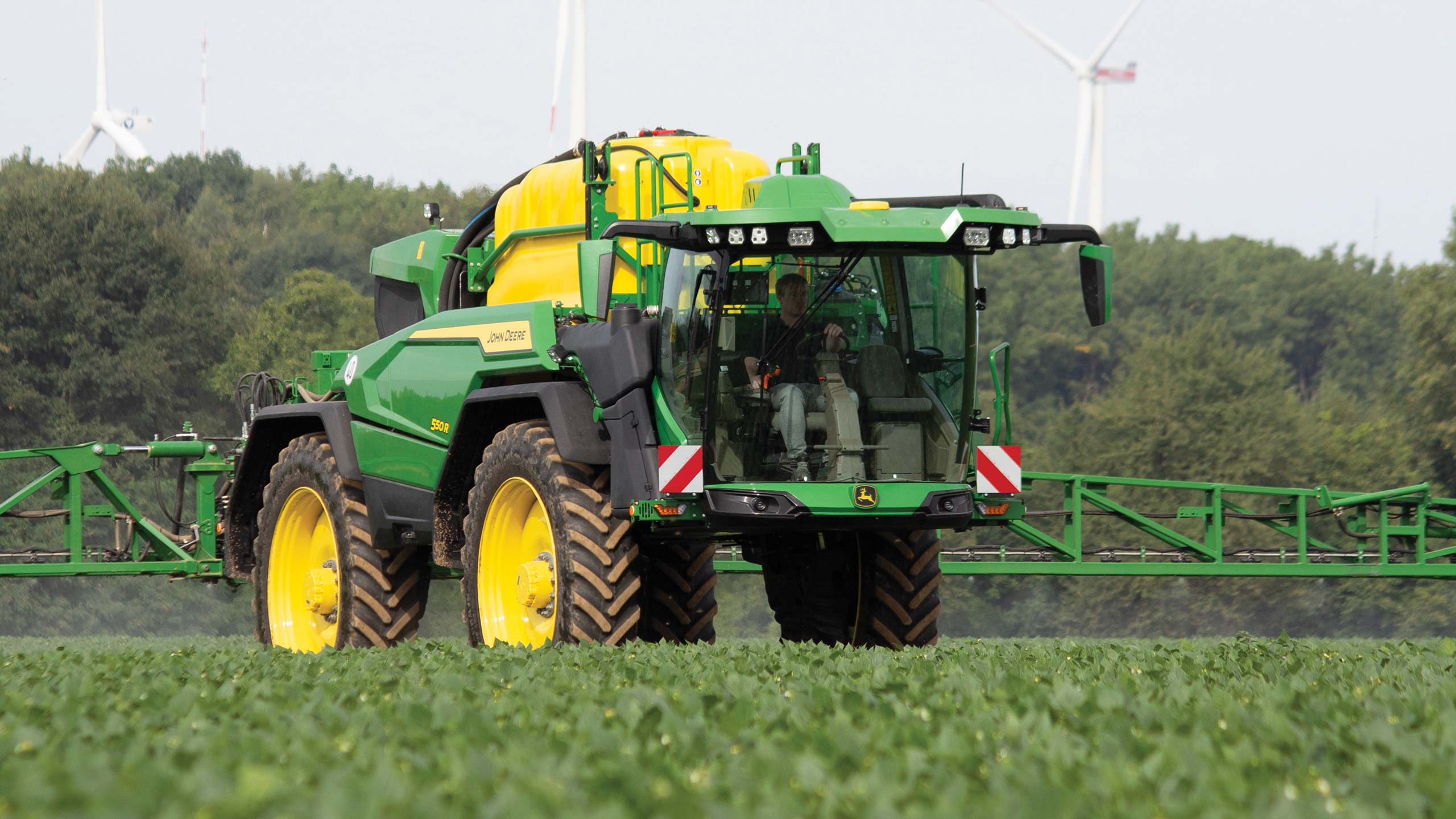First impressions: John Deere’s front-cab 550R sprayer
 © MAG/Oliver Mark
© MAG/Oliver Mark After years of peddling its US-style self-propelled sprayers in Europe, John Deere has finally ditched the comfortable but cramped mid-cab format for its new 500R series.
The last of those long-nosed R41s has just rolled off the firm’s production line at Horst in the Netherlands, freeing factory space for the newcomers to be built from the start of next year, alongside its quartet of R-series trailed models.
See also: First impressions: McConnel’s Agribuggy gets bigger and heavier
Sharp-eyed cynics will have already pointed out that these are not the first front-cabbed self-propelled sprayers to sport the firm’s leaping deer motif.
And quite right, too. Deere already has two models in the UK – the 175hp 332M and 225hp 340M.
However, these are not of Dutch provenance, but rather the result of a badge engineering exercise following its acquisition of Italian brand Mazzotti in 2017.
Though they have subsequently been fettled more to Deere’s liking, they are still built on Mazzotti turf in Ravenna and offered only in meat-and-potatoes M specification.
In fact, the Italians also have a machine in their portfolio that matches the 500Rs for size.
But the Green Giant has insisted on building its flagship European sprayer in-house – one that can cover more acres in tougher conditions than the simpler, lighter and less durable oven-ready option.

© MAG/Oliver Mark
John Deere 540R/550R
- Engine Six-cylinder, 6.8-litre Deere Powertech
- Max power 285hp
- Transmission Hydrostatic 40kph or 50kph
- Tank capacity 4,000/5,000 litres
- Filling pump 1,200 litres/min
- Spraying pump 1,000 litres/min
- Boom 30m or 36m
- Ground clearance 1.2m
- Track width 1.8-2.5m
- Machine width/height 2.55m/3.89m
- Empty weight 13.9t
- Diesel capacity 265 litres
To meet its exacting standards, the designers have ransacked Deere HQ for a ruck of tried-and-tested major components: the slick suspension of the outgoing R41s, six-cylinder engine of the 6R 250 tractor, spraying technology of the R900i traileds and, most importantly, the cab of the X9 combine.
Where does it fit in?
The output and comfort of the outgoing R41s meant they retained a small but hardcore following in the UK. In France it was the self-propelled market leader.
However, many potential customers here, and in the Netherlands and Germany, simply won’t entertain the cab position.
As a result, that heavy North American influence has finally been weeded out, with the new 500Rs designed specifically for the small-grain growers of western Europe.
For starters, it’s compact enough, at 2.55m wide and 3.9m tall, to handle our narrow roads.
And it hits the sweet spot in terms of tank capacity, with the 550R good for 5,000 litres and the 540R 4,000 litres; bigger versions may well materialise in due course.
Boom options are currently limited to 30m or 36m steel twin-folds. Deere keenly points out that demand for the latter is growing rapidly – and accounted for 95% of R41 sales – but a 24m will be available relatively soon.
The biggest differentiator between Mazzotti-sourced Ms and Deere-built Rs is the spec. Buyers of the latter can have every bell and whistle, most of which come as standard, which puts the 500s in direct competition with machines from Horsch, Fendt and Agrifac.
In contrast, the 300Ms are more rudimentary and, in terms of size, spec and price, likely to butt heads with the Brits: Bateman, Sands, Househam, et al.
Their early teething problems, most of which were electrical, look to have been ironed out and the 340M is apparently proving particularly popular, with 20 or so having been sold in the UK – the most of any country in Europe.
Also on the Deere roster are the R-series trailed sprayers. Like the 500Rs, these share plenty of high-tech features with the firm’s Des Moines-built mid-cab models, the 400R and bigger 600R – both big sellers in the US but way too wide for these fair lands.
Bigger cab
The main driver behind the development of the 500Rs was the clamour for a larger cab.
With no hope of finding space on the R41 to shoehorn one in from an 8R tractor – or even a 6R, for that matter – Deere had little choice but to start from scratch.
And, given that the mid-cab layout has proved a red line for so many potential customers – despite its greater ride comfort – the obvious decision was to move it forward and the engine back.
In a bid to replicate the comfort of the R41s, these new machines have been fitted with the same Xtra Flex dual strut air suspension system, the assemblies for which are tucked as deeply as possible into the wheel rim to minimise crop damage.

© MAG/Oliver Mark
The cockpit will be familiar territory for anyone with a T, S or X combine, or an F-series forager.
It is quieter and more spacious than the pokey setup of old, with matchstick-thin pillars and floor-to-ceiling glass giving an almost uninterrupted view of the acres ahead.
As well as the standard-issue Deere features – fancy swivelling seat, snack fridge, smartphone-friendly multimedia system – full production models will come with an automatic door cinch to ensure any spray drift is kept out.
And, in line with their “top spec” billing, a Starfire receiver is integrated into the roof as standard, they come with over-the-air access to the JD Link platform, and the software has been completely revamped – making it easier to add new features with minimal engineering effort.
Almost everything is set via the app-style layout of the main G5 Plus Command Center display, including a headland management system that can alter forward speed and boom height, and stop/start the master spray switch and four-wheel steer.
Spray pack
Most of the main spray pack features have been carried over from the R41s and will also be familiar to anyone running an R-series trailed.
But the boom stability system has been updated, with a centre pivot assembly supported by twin cylinders to control roll and vibrations, and another pair of rams that dampen any yaw.
Height control is based on feedback from five sensors dotted along the boom.
This can be set to work off the distance from the ground, crop canopy, or combination of the two, to offset any funny readings caused by lodged or patchy crops, or tramlines.
It’s also possible to deactivate a particular sensor if, for instance, it’s travelling over a bare strip around the headland of a potato crop.

© MAG/Oliver Mark
As with most of Deere’s sprayers, these new models come with the dual circuit PowrSpray system with two centrifugal pumps – one of 1,200 litres/min for filling and a second of 1,000 litre/min for spraying.
Given it takes just five minutes to brim the tank, an “active pause” function is available on the former. This strangles the flow and redirects it to the induction hopper, allowing operators to load products and wash out containers at a leisurely pace.
Also standard are automatic rinsing and boom folding functions, and air shut-off nozzles and section control.
But wafting another £30,000 or so under the dealer’s nose will add the 36m Exact Apply package – something that has been offered on the R41s since 2019.
This brings pulse-width modulation into play to maintain a consistent droplet size regardless of forward speed, as well as individual nozzle control, automatic nozzle switching and turn compensation.
However, as with the tank and boom options, the rest of the spec is far from complete.
For starters, the firm’s See and Spray spot-spraying system is, as yet, unavailable on 500Rs. The company says it is focusing on getting it tuned up on trailed machines first.
And, though the induction hopper can take a feed from a closed transfer system, it’s not integrated into the sprayer. Buyers wanting to go down this route will need a separate, standalone unit.

© MAG/Oliver Mark
Drivetrain
The cab/engine/tank reshuffle has necessitated some jiggery-pokery in the powertrain department.
But the biggest and most expensive components remain unchanged. For one, it’s the same six-cylinder, 6.8-litre block as before, tuned to put out 285hp – marginally up on the R41s – and stay as close as possible to 1,350rpm during work to minimise fuel consumption.
This powers a hydrostatic pump that runs the individual Danfoss wheel motors with a top speed of either 40 or 50kph.
As a result of the engine repositioning – and the consequential awkward access – all the fuel and oil filters and drains have been slotted ahead of the nearside wheel arch.
It is possible to get a better look at the block by sidling along the rear fenders, which are apparently strong enough to handle the weight of two big fellas when they’re pushed out hydraulically to the maximum 2.5m track width.
Getting sight of the engine dipstick and coolant level isn’t easy, though, so, love it or loathe it, readouts for these are now displayed on the in-cab screen.
The cooling system has been revamped to account for the rejig, with a new hydraulically driven fan sucking air from between the wheels and spewing it out above the engine to avoid inadvertently upping the wind speed around the nozzles.
There has also been a tweak to the steering, with the introduction of a minor delay between the front and rear wheels turning. This should keep it tracking tramlines more accurately and eliminate any oversteering on sharp corners.

